How Much & How Often to Water Bougainvillea: Tips & Tricks
-
Lindsey Lawson
- Last updated:

The stunning bougainvillea is an ornamental plant that comes in many different varieties and colors and is a favorite among landscapers. Properly caring for bougainvillea is essential for its survival so that it can continue adding vibrancy to your yard. So, how much and how often do you water bougainvillea? That depends on the season. Read on and we’ll go over this plant’s watering needs and overall care requirements.
Bougainvillea at a Glance
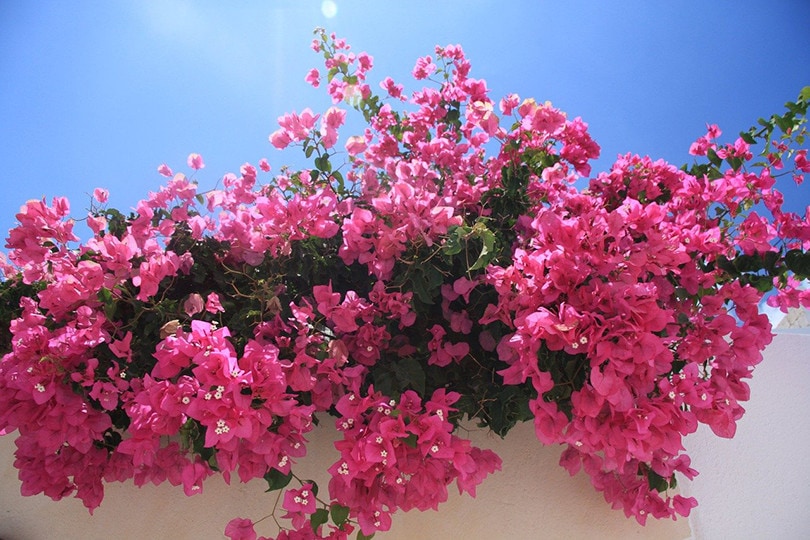
| USDA Hardiness Zone: | 9-11 |
| Soil: | Well-draining loamy soil |
| Fertilization: | Once per month during the growing season (spring and summer) |
| Watering: | Deeply water every 3 to 4 weeks |
| Temperature and Humidity: | 60-85 degrees Fahrenheit, 50% humidity or higher |
| Lighting: | At least 6 hours of bright, direct sunlight |
| Propagation: | Stem cuttings placed in soil |
About Bougainvillea
Bougainvillea is a genus of around 18 species of vibrant blooming thorny vines, bushes, and trees. They belong to the Nyctaginaceae, or four o’clock family, and are native to Central and South America. These plants are very showy and are used ornamentally to enhance landscapes.
In the United States, they are most often cultivated in South Florida, Southern California, Arizona, and South Texas. They are typically a hardy species that will grow year-round in tropical climates but are used as annuals in colder climates.
Bougainvillea is fast-growing and has stiff, thorny stems that are covered in heart-shaped leaves. Their vines can grow up to 40 feet tall when given the proper support. There are also low-growing shrub varieties that only reach a few feet tall, which are popularly grown in containers for show.
Bougainvillea blooms come in a variety of colors including purple, red, orange, white, pink, and yellow. These blooms are modified paper-like leaves called bracts that hide the plant’s real flowers. The true flowers that can easily go unnoticed are tiny trumpet-shaped blooms that are either white or yellow.
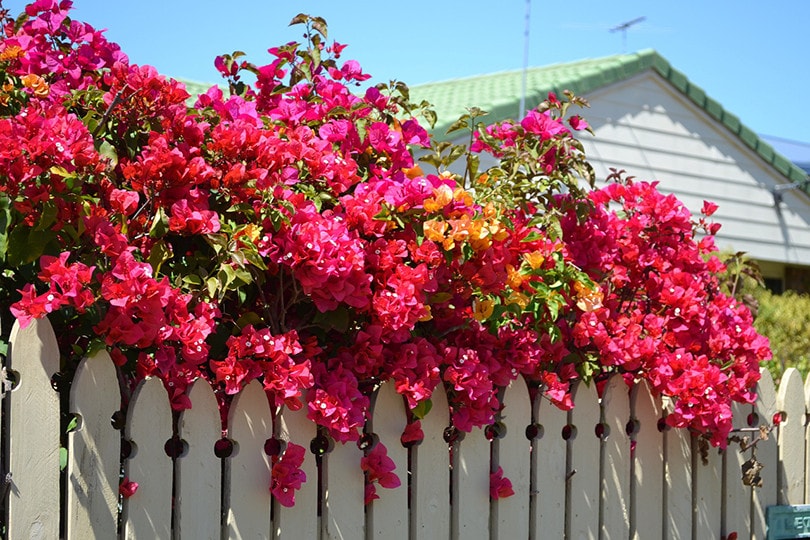
Planting and Caring for Bougainvillea
Like a tropical plant, the bougainvillea has certain care requirements that must be met for it to successfully grow and bloom those sought-after bracts.
Watering Bougainvillea
You will first want to water your bougainvillea after it has been planted and then once per week until the plant has become fully established. Since bougainvillea is fairly drought-resistant, it will not need a lot of water once established.
Never water your plant often and in small amounts, as this can cause a weak root system. When watering, make sure to do it thoroughly and generously then allow the soil to dry out in between watering. Overwatering a bougainvillea can cause root rot, a lack of flowering, and the dropping of leaves. Underwatering will cause the bracts and the leaves to fall. Off.
Outdoor Bougainvillea
Outdoor bougainvillea will do well with a deep, thorough watering about once every three to four weeks. This plant should never be allowed to sit in standing water due to the risk of root rot.
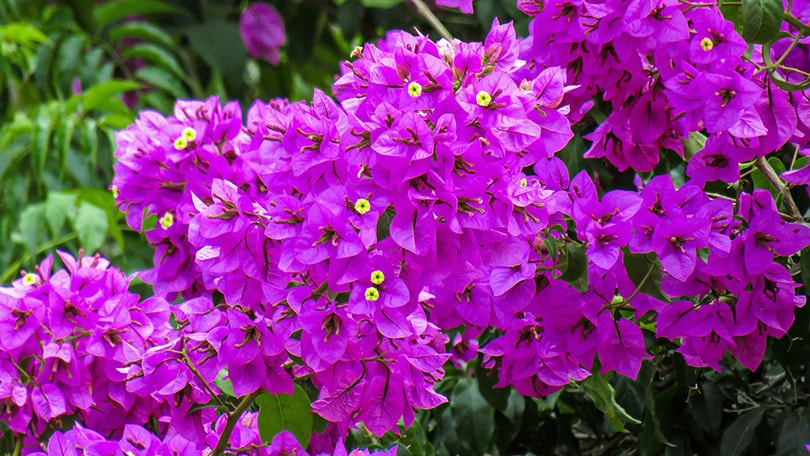
Indoor Bougainvillea
Potted bougainvillea that are kept indoors have similar watering requirements. They should be placed in well-draining soil in a pot that drains naturally. Water the pot generously to keep the soil evenly moist and do not water again until the top half of the soil has become dry. Watering will be less frequent during the fall and winter, at about every 2 to 3 weeks.
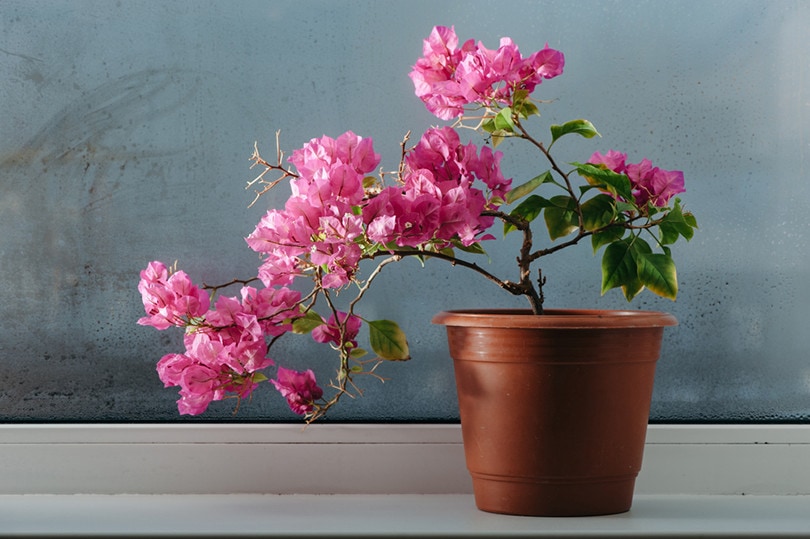
Light Requirements for Bougainvillea
Regardless of whether a bougainvillea is planted outdoors or is kept indoors in a pot, it should get at least 6 hours of direct, bright sunlight per day. Make sure to plant (or place the pot) in a sunny area that will get the necessary amount of light each day. A lack of light is the primary reason that a bougainvillea will fail to flower.
Temperature and Humidity Requirements for Bougainvillea
The bougainvillea thrives when temperatures range from 70°F to 85°F during the day and between 60°F and 70°F during the night. During winter dormancy, bougainvillea prefers temperatures between 50°F and 60°F. These plants cannot tolerate extremely low temperatures, which is why they are grown as annual plants outdoors in colder climates or are kept in pots indoors.
Bougainvillea likes high humidity of at least 50 percent, especially when it is getting ready to bloom. During the winter dormancy period, it requires much less humidity. For indoor bougainvillea, it’s a good idea to give them regular misting when they are nearing their bloom.
Choosing the Right Soil and Fertilizer for Bougainvillea
Bougainvillea has thin roots, so they require rich, well-draining soil. A nice loamy soil or your typical potting mix will work just fine for these plants, but you need to ensure that you do not use soil that contains peat or any other water retaining substances, as this will risk root rot.
It’s best to provide fertilizer monthly when the bougainvillea is in bloom with a bougainvillea or hibiscus plant food that is rich in iron and other micronutrients to help strengthen their thinner roots and increase the number of blooms.
During winter dormancy scale the fertilizer back to every other month, diluting the plant food to half the recommended strength. Always fertilize when the soil is moist because if you do so when it is dry, you risk burning the roots.
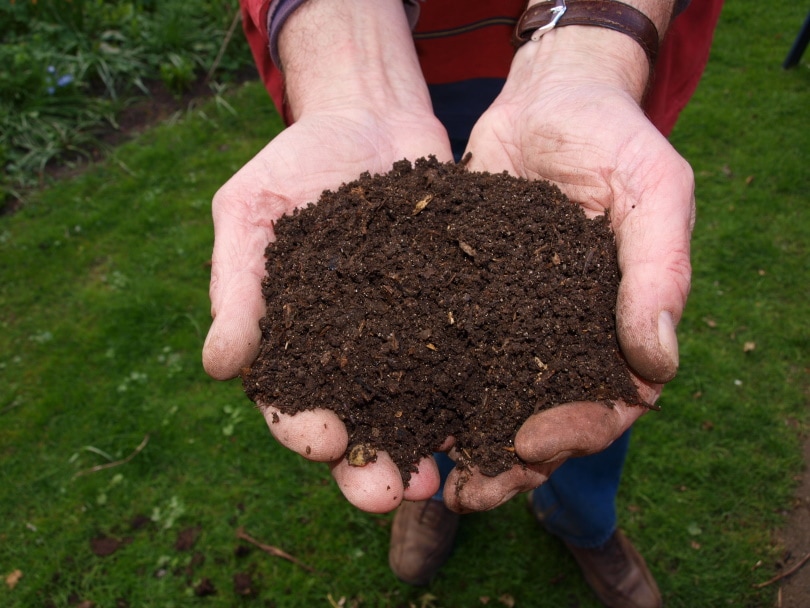
Final Thoughts
The bougainvillea is an incredible ornamental plant that is surprisingly hardy for being a tropical species. They can be grown in pots or planted outdoors but will not tolerate colder climates well. This plant is drought friendly and will do fine being watered thoroughly every 2 to 3 weeks with even more time in between during the fall and winter seasons. As a good rule of thumb, water when the top half of the soil becomes dry.
- You may also be interested in: How Much and How Often to Water Peperomia
Featured Image Credit: fotofan1, Pixabay
Contents
